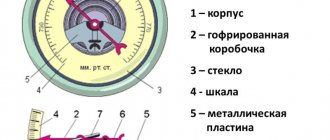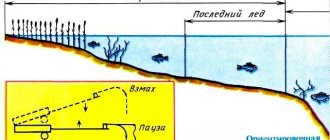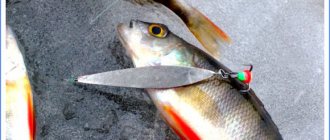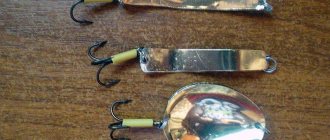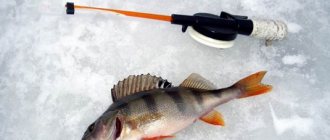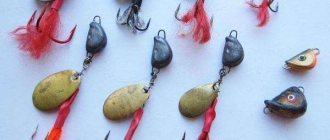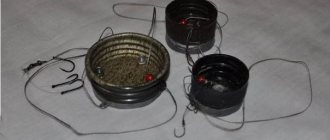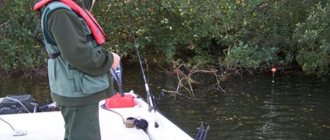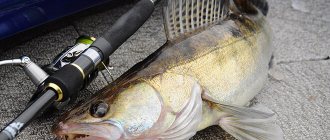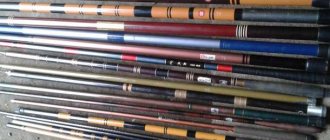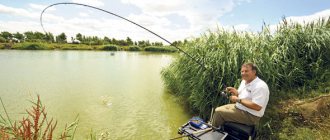Perch: description and behavioral characteristics
Perch is a river fish with red fins and a striped body. The fins are equipped with sharp spines and if you handle the fish improperly, you can get pricked, but this is not contagious, because the spines of the perch are not at all poisonous. Perch does not grow large in size; depending on the diversity of plankton in reservoirs, its weight can reach only up to 3 kg.
The predator is sensitive to changes in atmospheric pressure (in particular, its swim bladder), so the bite stops at low or high pressure until the perch adapts to sudden changes. Usually the perch bites during the daytime, but dozes off at night, preferring to stay in cover.
Hunting for perch is preferable at dawn in the upper layers of water, when perch gather in schools and begin to look for food. Can migrate and swim to distant places.
There are two types of perches: small-growing ones weighing no more than 30 g, which go mainly for spawning, and fast-growing, dark-colored large individuals weighing up to 3 kg, preferring to live in open areas of ponds and reservoirs. Although the weight directly depends on the habitat and feeding conditions of the fish.
Habitats
It prefers to be found in river beds, stagnant bodies of water with densely populated algae, on riverbed edges with trees leaning towards the water. It is in these places that worthy specimens are found, also in deep parts of the reservoir, where they prefer to flock together and move long distances in a school, chasing small things.
Perch habitats
Fish reproduction mainly occurs in European waters. In Russia there are a lot of perch in the Lena River; quite large specimens are found in the reeds near the sandy rocky bottom, in places with islands and flowing currents. You can often catch perch in places with sunken trees, where the predator comes out to feed and feast on small minnows. When choosing a place, it’s a good idea to fish near rifts with a pebble and rocky bottom, where perch feed on plankton.
Perch is a schooling fish and where there is no plankton, the little ones feed on whatever they find. Large individuals are more picky about food and can live alone, feeding on fry, but they are always a good catch for fishermen.
Biting calendar by fishing season
The bite is successful in the spring , when the fish, hungry after winter, go to feed and on warm days begin to feed heavily both in the current and in places with standing water.
Fishing is successful almost throughout the summer and, knowing the area, it is possible to catch large specimens.
The bite does not stop in September , when the perch begins to go into the depths and hide in the thickets.
The largest individuals can also be caught in October using light bait, as long as the weather is warm. Towards the end of October, the time comes to change baits to heavier ones, and prefer to catch fish in deeper places.
In early November, perch begin to flock together in schools and remain so until spring. But even at this time, fishing is rushed when fish are crowded. In the chosen place you can fish with jigs, vibrotails and twisters, when fishing for pike is also successful. If the days are warm in November, then it is quite possible to catch stripers. By the end of the month, the perch sometimes bites, sometimes doesn’t bite, and the bite is inconsistent. Basically, large specimens are encountered periodically. During moments of active splashes on the water, you can catch quite significant trophies on a jig, organizing raids at great depths, where perches prefer to be at this time.
Advantages of using spinners for perch
Lure fishing is successful all year round. It is best to fish in winter, using them as bait to catch large individuals, playing with the bait, copying the movements of the predator. Perch reacts quite well to bright lures and bites successfully.
Today there are many spinners on sale with different sizes and characteristics.
When choosing, it is necessary to take into account fishing conditions, as well as knowledge of the area.
Spoons, unlike natural baits, can be used repeatedly. However, they will not be useful when used in muddy waters, as they will simply become unattractive for the fish to play with.
The fish are mostly found where weeds and snags are common when using other baits. Spoons do not cling and are successful when catching perch in such places.
Winter bottom spinner for perch TOP 8 best baits
Based on the opinions of anglers, you can make a rating of winter spinners:
- NILS MASTER HANSKI . A distinctive feature is the use of a chain for equipping with a tee with a drop of plastic. Used at great depths.
- KUUSAMO SINFONIA . The spinner has a curved body that expands at the top. Made with a single hook.
- KUUSAMO KILPA-LOISTE . Small size spinner. 35 mm and weight 3 g. But this does not interfere with the capture of large specimens.
- KUUSAMO LEIJA . It is an elongated cone that tapers downward. The blades are located on top.
- KALAMIES 6 HOP-MES . Relatively heavy spoon. The shape resembles the keel of a ship. Due to this, it is able to move under ice over considerable distances. A single hook is used with the bait.
- HALI LINDROOS LUXUS . It features original animation due to its shape. This makes the spoon a desirable target of attack even for inactive perch.
- RAPALA BERGMAN BWB030 SG . With the help of a spinner, it is possible to catch any predatory fish. It has a convex and concave body. Thanks to this, he plans well.
- RAPALA SM-PIRKEN SM45-SG . The bait has phenomenal catchability. The highlight of the spinner is the realistic eye on the body of the bait.
Criteria for choosing a spinner
When choosing artificial baits, you should pay attention to the shape, size, color and hooks. So:
- size is No. 13. The smallest spoons are difficult to cast, but large ones can scare the fish, so the size should be taken into account. The best is the golden mean.
- shape for perches is oval with a petal deflection of 60°.
- Color , perch has a good reaction to red. A predator will bite well on a bait with such a pigment, especially in clear weather, when you need to use fairly bright baits with smooth petals to sparkle in the water to attract perches.
- The hook is an integral part of rigging. It must be of high quality with a sharp sting and a ring for attaching to the fishing line, also soldered evenly in the center of the bait. The tip should be slightly concave inward. It is preferable to catch perch using spinners so that the bait vibrates well, flickers and plays in the water. Rotators are suitable for fishing both in still water and in large currents.
Top 7 best spinners
- Super Vibrax Blue Fox , a popular bait for bass. It has excellent characteristics and is preferable for playing when fishing at a depth of more than 2 m. This is an excellent spinner with oval blades and a rotation angle of 45°. The weight is only 8 g with a rotating blade and a weight equipped with acoustics, which makes the bait particularly catchy for perch.
- Adlia Lonq Rainbow 2 Mepps from the Merz company with oblong petals and enough weight to hold the game with fish in the current. The spinner is suitable for deep lakes, equipped with long white petals with a rotation angle of 30° and weighing 10 g.
- The Niakis 8 Smith is considered a quality bait for catching perch at any depth down to the two-meter level. This is a spinner with oval petals with an angle of 60° and a symmetrical core weighing 12 g, which is what makes this bait special.
- lukris Sella Small-sized spoons, favored by perch, are quite effective when you immediately install tees on the bait, which are unable to break and bend under the weight of the fish. Available for sale in three colors.
Super Vibrax Blue Fox
Adlia Lonq Rainbow 2 Mepps
Niakis 8 Smith
lukris Sella
Pontoo21 Ball Concept 1.5
Mepps Comet Decor
Muran Mira - Pontoo 21 Ball Concept 1.5 is a popular model sold everywhere in fishing stores with a weight of 4-5 g and a petal length of up to 27.8 mm.
- Mepps Comet Décor petals weight to keep the game with fish on the water. It is catchable regardless of the current and is preferable for catching predators in the depths of lakes and reservoirs. The bait is noisy with narrow petals, which can be used to catch other predators, not just perch. But it’s quite light, it just flutters on the water, like a small moth. At the same time, use it anywhere: with flowing water or in standing river beds. Even an inexperienced angler will immediately feel the play of the bait and the resistance of the fish when fishing. It is this kind of spoon that will be attractive to perch even in the heat, when it is lazy and does not want to go for any bait at all. Mepps Comet Décor is good for catching perch in the summer. The spinner is equipped with one petal with painted spots of different colors. The bait is quite floaty when cast and hits the catch point directly.
- Muran Mira has proven its performance on water. Available in 4 colors with a double hook, well disguised as a fluffy tail. The bait weighs 2 g and has proven its effectiveness on the water.
Top best perch lures
Without begging the merits of homemade perch baits for winter fishing, let’s move on to describing the 10 best spinners, according to the Russian segment of the Internet.
Nils Master Hanski
Finnish winter lures are rightfully considered one of the best, because the residents of the country of Suomi understand a lot about winter fishing. One of the examples of catchable bait is Nils Master Hanski.
Spinner Nils Master Hanski.
This stud style lure is equipped with a hanging treble on a chain. The hook is decorated with a combination of red and green plastic in the form of a teardrop. Open-type chain clasps allow you to quickly unhook and attach the anchor.
This winter vertical works great in deep water for trophy bass. Sometimes pike perch and bershi are tempted by it.
Kuusamo Sinfonia
This spoon also comes from Finland. It differs in equipment and shape from the previous one and is a cross between a carnation and a glider.
Perch bait Kuusamo Sinfonia.
The body of the spoon is curved and expands upward. The bait is equipped with a hanging single hook.
The use of the spinner is universal. It works well both on a small pond and under the steep bank of a large river.
Kuusamo Kilpa-Loiste
Another model from Kuusamo. This small spinner is great for catching a passive predator.
The holographic body and the tee decorated with colored cambric are additional irritants for the predator.
Kuusamo Kilpa-Loiste weighs only three grams and is 35 millimeters long. However, not only sailors, but rather respectable humpback whales are encroaching on her.
Kuusamo Leija
This sample of the Finnish company has several standard sizes. For catching perch, the manufacturer recommends using a bait 540 millimeters long and weighing six grams.
Kuusamo Leija: bottom - stud, top - glider.
Kuusamo Leija is made in the form of an elongated cone, tapering downward. In the upper part there are blades for planning, they also allow the spoon to scour from side to side. The bait is equipped with a hanging single hook on a short chain.
They use a spinner in deep horizons, although at shallow depths it is also quite catchy.
Kalamies 6 Hop-Mes
The spoon, which has a decent weight, works at great depths of 5-10 meters. The body in the form of a ship's keel allows you to glide far to the sides under the ice. A single hook is attached with a short chain to the pointed end.
The widening in the middle of the bait allows it to glide well near the bottom.
Hali Lindroos Luxus
The small-sized spinner has an original animation that allows you to seduce even a sedentary, passive perch.
The convex side of the bait is corrugated, which creates small swirls along the body when moving.
The bait is made in the shape of a classic glider and is equipped with a tee on a chain, decorated with multi-colored beads. The spoon works well in cloudy water due to the decorations used and the surface structure.
The weight of a bait 40 millimeters long is 7 grams.
Rapala Bergman BWB030 SG
An excellent universal lure for a variety of predators. The sweeping action of this glider will seduce not only perch, but also pike perch and pike.
A tee decorated with a droplet is an excellent aiming point for a predator.
The body of the spoon is convex-concave, which allows the bait to glide under water for a long time.
Rapala SM-Pirken SM45-SG
This sample from Rapala is simple at first glance, but the catchability of the SM-Pirken SM45-SG is simply phenomenal. Maybe this is due to the shape of the body, or maybe the finishing used on the bait.
One of the features of the spinner is a realistic eye.
The spinner is equipped with a tee on the winding ring.
Rapala Arkku ARK 70 SG
This miracle of the famous Finnish manufacturer is distinguished by its tetrahedral shape and a long pendant chain compared to its analogues.
The shape of the spoon allows you to successfully fish both in the current and in calm lake water.
Lucky John Scandy
A classic spoon with a slightly bent bottom and a tee or hook on a chain. Length – 55 millimeters, dead weight – 6 grams.
A gliding spoon with a suspended decorated single spinner.
How to do it yourself?
Often fishermen make their own spinners, and the classic model has shown itself well when catching perch at depths of up to 80 m.
For homemade production, you need to stock up on: pliers, a vice, a hammer, a file, metal scissors, a soldering iron, a drill, and a grinder.
Homemade spinners
For the material you need to select hooks with a sharp sting, lead or brass for solder, a piece of metal plate.
To make a spinner you should:
- cut a strip up to 35 mm long with metal scissors;
- round off the sharp ends with a file;
- lay the workpiece on the lead, connect it with a nail;
- solder with melted lead using a soldering iron;
- fill the resulting voids with liquid tin;
- drill two holes along the edges of the spoon;
- insert a ring for tees into one hole;
- attach a fishing line with red cambric to the second hole;
- Apply a layer of brass on top, level with a file;
- sand the edges.
It is not at all necessary to buy such a bait in a store, because you can make it yourself, you just need to buy a copper bushing. The output should be a spinner like a small crucian carp up to 5 cm in size. This will be a very catchy bait for fishing in summer and winter, when the fish will respond to both short and wide tackle.
A homemade spoon is suitable for fishing in shallow water. But, the main thing is to be able to conduct the retrieve correctly, and for this you need to make a lure that exactly imitates all the movements of the perch.
For fishing in muddy water , you will need a hook number 12, a metal drill up to 2 mm in diameter, pliers or pliers, metal scissors, a chrome-plated tube, a soldering iron, and tin.
Bottom spoon
To make a bottom spoon:
- cut the chrome-plated tube into 2 parts; to produce one spinner, one half will be enough;
- bend the pipe so that the surface becomes flat;
- cut around the edges in the shape of a fish with metal scissors;
- sharpen the corners with a file;
- apply soldering acid to the workpiece at the back;
- attach the hook to the spoon;
- apply another layer of tin;
- drill a hole through which to pass a fishing line with a leash;
- sand all edges with sandpaper;
- rig the hook with cambric.
The bait for fishing in troubled water should be 35 mm in length, 10 mm in width, and 3-4 mm in width near the hook.
Tackle for catching perch with a spinner. Selecting a spinning rod: rod, reel and line
The requirements for a spinning rod are very democratic - almost any of the modern “sticks” will be suitable to a greater or lesser extent. The classic recommendation is that slow or moderate action spinning rods are most suitable for catching perch with spinners. In principle, this statement is true, but you also need to take into account the type of spinners, their size, weight and the corresponding wiring technique.
The slow “rod” allows you to cast the bait further due to the inclusion of the entire form in the work. The fast one allows you to make an accurate cast with a short swing, a “click.” One disadvantage of rigid rods is that there are a lot of slippages, although this can be compensated for by correctly setting the reel drag.
The casting weight test should correspond to the weight of the baits used, but that’s not all. Rotating spoons, even of the same weight, due to the different shape of the petal, create different resistance during retrieval - that is, the convenience of casting a spoon does not guarantee its comfortable retrieving. Ideally, the spinning rod should be matched to the available bait, and not vice versa.
The specifics of perch fishing somewhat simplify our choice - large numbers of spinners, as a rule, are not used. The most suitable rod for us is a medium action rod, weighing up to 12-15 grams, with a soft tip to control the work of the spinner. There are no special requirements for the material (we don’t need hypersensitivity); it could very well be a composite. The optimal length of the spinning rod is 240 cm for coastal fishing and 210 cm for boat fishing.
Personally, for several years I used two spinning rods, which were given to me for my wedding, to catch perch with a spinner. These are quite budget products from Salmo's Supreme Carboxy series, 240 cm and 180 cm long, casting 5-20 and 3-14, respectively. The material is carbon im 6 (written on the form) or composite (written in the catalogue), but that’s not the point.
This pair suited me quite well for a long time - a certain power reserve of the first and the slow action of the second made it possible to comfortably use all the small spinners available at that time. There are now a huge number of similar (and even better) models of spinning rods; the question of choice is personal preference and the thickness of the angler’s wallet.
For the increasingly popular ultralight spinning rod with a test weight of 5-7 grams, very tiny microspinners, often handmade, and trout microspinners are used. A necessary condition for comfortable fishing is the presence of a commensurate reel that works well with the thinnest fishing lines and cords.
Choosing a reel for “light” perch fishing with a spinner is even easier than choosing a spinning rod. Any, even inexpensive, reel of size 1000 or 2000 according to the Shiman classification is suitable. When fishing with spinners, the fishing line or cord is always placed on the spool under load, which ensures an even and tight lay and prevents the release of loops, so “favorite” by adherents of jerking retrieves.
When winding fishing line or cord, the reel spool should be filled almost completely, not 2-3 mm short of the edge of the side, otherwise you won’t be able to cast light perch baits very far. It is very important that the tackle is balanced - the center of gravity lies within the spinning rod handle.
Although the total weight of the assembled tackle is small, the balance shifted to the tip and the “nodding” rod are quite annoying, especially when spot fishing in windows among the grass, when casting under overhanging tree branches, where a jewelry presentation of the bait is required.
When fishing, we strive for harmony with both nature and equipment, so the “rod-reel-bait” set must be selected impeccably. Ideally, the spinning rod should be felt by the angler as an extension of his hand, then fishing will be a joy, and striped bass will be caught well. But the result of fishing often depends on our mood.
Line or cord? In principle, you can catch perch with both. Ideally, it is good to have two spools with you - one with fishing line, the other with cord. The fishing line has advantages: it is not so noticeable in the water, its shock-absorbing properties reduce the number of slips. The negative aspects of the fishing line include the presence of residual deformation after heavy load, and, in general, low mechanical strength.
Having torn off the bait on the hook a couple of times (and perch fishing mainly takes place in places where there is a danger of hooking), you can safely throw away the entire working piece, since its strength has decreased significantly. If you decide to fish with a fishing line, then take a line with a diameter of no more than 0.2-0.22 mm (you shouldn’t go thicker) - the casting length will be significantly reduced, although in case of a serious snag this will not help.
I recommend using braided wire with a diameter of 0.08-0.1 mm. It is much more convenient to fish both overgrown shallows and deep dumps with a cord, and it is completely indispensable for step-by-step guiding of front-loaded spoons and small spoons. The quality of the inextensibility of the cord (a potential cause of the rupture of the lips of a perch with its subsequent removal) is easily compensated by a correctly adjusted drag of the reel. For camouflage, you can place a fairly long fluorocarbon leash in front of the bait, almost invisible in the water.
A serious problem is the strong twisting of the fishing line or cord when fishing with centrally loaded spinners. Without claiming to be the absolute truth, I will give some recommendations on this matter:
— unwind 30-40 meters of fishing line (without bait and accessories) on the shore, stretch it and wind it on a reel; if you are sitting in a boat, you can lower the fishing line downstream;
— before casting, increase the overhang of the bait and wait a little while it unwinds the line;
— periodically use a crankbait or silicone instead of a spinner;
— use high-quality swivels;
— if possible, do not use first-generation flat cords for spinner fishing; it is preferable to use fishing line;
— tie a large fly onto the tee of the spinner or equip it with a twister, which will slightly stabilize the axis of the bait.
For myself, I have not completely solved this problem, but I have minimized the negative by using high-quality triple swivels (used when fishing with bombarda-sbirulino). Also, sometimes I install two high-quality swivels. One is at the junction of the leash with the cord, the second is through the winding ring, right on the turntable.
Equipment equipment
Perch gear includes:
- The rod should be quite rigid and fast in action, 1.5 m long with a cast of 40-45 g.
- The fishing line is suitable for catching perch, monofilament or fluorocarbon with a diameter of 0.27 mm. The perch does not grow too large, so this diameter of the fishing line will be enough and there will be no breakages.
- The reel should be quite powerful with a spool size of 1500. The capacity of the fishing line in the reel is up to 70 m.
TOP 10 best winter and summer lures for perch
| Photo | Name | Rating | Price | |||
| Summer lures for perch | ||||||
| #1 | Mepps Black Fury | ⭐ 99 / 100 1 - voice | Find out the price | |||
| #2 | Myran Agat | ⭐ 98 / 100 | Find out the price | |||
| #3 | Pontoon 21 Ball Concept | ⭐ 97 / 100 | Find out the price | |||
| #4 | Blue Fox Super Vibrax | ⭐ 96 / 100 1 - voice | Find out the price | |||
| #5 | Mepps Comet Decor | ⭐ 95 / 100 2 - votes | Find out the price | |||
| Winter lures for perch | ||||||
| #1 | Kuusamo Sinfonia | ⭐ 99 / 100 1 - voice | Find out the price | |||
| #2 | Nils Master Hanski | ⭐ 98 / 100 | Find out the price | |||
| #3 | Lucky John Scandi | ⭐ 97 / 100 | Find out the price | |||
| #4 | Rapala Bergman | ⭐ 96 / 100 | Find out the price | |||
| #5 | Hali Lindroos Luxus | ⭐ 95 / 100 1 - voice | Find out the price | |||
Which lure would you choose or recommend?
Take the survey
Depending on the season of the year, spoons of different structures are used to catch perch or other fish. They differ primarily in appearance and color. The rating presents five options for winter and summer bait, which will not be difficult to catch a perch even for beginners.
Techniques and tactics of catching perch with a spoon
The main thing on a pond is to designate all the fishing points, make a plan and then make the first cast of the bait. At the same time, you should not sit in one place for a long time if there is no bite. The perch is quite active and quickly detects the bait. If the bites stop, then there is simply no perch in this place, and he left it a long time ago.
When fishing for perch, it is important to pay attention to fishing technique and tactics. You must first test the lure on the ground. Start it so that it taps freely on the ground, then:
- raise the bait to a height of up to 2 m;
- lower slowly;
- count to 5 seconds;
- after the bait reaches the bottom, immediately raise and lower the spoon again;
- play with the bait, pausing for up to 5 seconds;
- after which you can begin the raid and cross the middle layers of water.
Perch is caught well with live bait, so it is necessary to put such bait on the hook so that the predator quickly pecks at it. When the fish is starving, the color of the spoon does not play a significant role. If the water is cloudy, then the color and size are still worth taking into account.
When playing with a lure, it is advisable to bring the perch to the surface for fishing. Fishing is successful if there is a small cut or protrusion on the surface of the water, since lowering the bait in a vertical position will only significantly increase the frequency and degree of bites.
How to catch perch with a spoon
And before you decide on the most popular lures for perch, you need to familiarize yourself with some of the rules that you should follow on the pond. Firstly, the location of the perch and the bait it will take depends on the time of year. In cold seasons, perch prefers to be in the depths and goes to the pits following its food supply. In cold water, the activity of the fish decreases, so it is worth using more passive baits. And it would be logical to use heavier baits to get perch from their winter camps.
In the summer, when the water is warm, perch goes to shallow places where the water is warm and prefers to stay there all the time. Here you won’t need heavy baits and long casts; spinners weighing up to 6-7 grams and a spinning rod 240 centimeters long will suffice. Perch loves various heterogeneities in the coastal zone. Various fallen branches and sharp drops will obviously be to his taste, and therefore such places should be given attention when catching perch with a spinner in the summer (read more about catching perch with a spinning rod).
Important! Don’t forget about the banks overgrown with reeds, where it is very convenient for fish to stand waiting for prey throughout the day.
First you need to divide all the spinners into the two broadest categories:
- a rotating spinner, or popularly known as a spinner;
- oscillating spoons.
Tips and tricks
- Experienced fishermen advise not to fish too fast to avoid snags near algae and reeds. It should be done slowly and smoothly, with short pauses.
- You should not cast bait over long distances. Perch is found near the shore and in coastal areas.
- If spinners are used, then it is necessary to stop them for a moment so that the perch pays attention to them and thinks that this is a real live fish.
- When fishing with spoons, wiring is used, since only such baits are similar to real live fish, exactly imitating all its movements on the water.
- When fishing, you need to use weather conditions and atmospheric pressure.
- The bite will be better if the spinners are equipped with black or red stripes or specks.
- In summer, perch is active in the surface layers. Fishing is successful during the day, but in the heat the perch goes into the water column.
- After landing the fish, you need to change the parking place and move to another, since most likely there will be no bite in the previous one
- To catch large specimens, it is necessary to add live bait to artificial baits on the hook so that the fish attacks and actively captures the bait.
- Fishing with spinners is successful for performing wavy or uniform retrieves closer to autumn, when the fish are already found with quite a large weight.
- It is better to choose sunny weather for fishing so that there is no wind, although this is not dangerous for perch.
- The predator is well caught in shallow water, shallows, and in desalinated waters in summer.
- With the onset of autumn, perch prefers river mouths, where they spend the winter until subsequent spawning.
- In the sea, fish that have fattened up and gained weight are found to be quite large in size.
- Perches spend the winter mainly in calm water, where they live in a half-asleep state; on good calm autumn days you can catch a good catch by midday. In the morning, activity is reduced and even the best bait will not force the predator to attack.
- In autumn, it is recommended to take into account the barometer readings before going fishing. If there is high pressure and stable weather, this is a good time for fishing.
The main thing when catching perch is to choose the right spoon and bait. Perch fishing is a real hobby. Knowing the characteristics, habits and habitats of this predator, successful fishing is guaranteed.
Winter fishing with spoons from the bottom
Winter fishing with spoons from the bottom
Let's chat about spoons designed for fishing from the bottom. For some reason, all the books describe the method of trolling precisely in the water column, i.e. at a time when the spoon does not touch the bottom.
Despite the fact that everyone knows that one of the secrets of jig fishing is that the bait, at the end of each game cycle, falls to the bottom and raises a cloud of turbidity. Often pike perch and perch attack a spoon or jig directly on the bottom.
Based on this, the bottom trolling method was justified and created. I have a whole set of spinners designed for fishing from the bottom. There are quite a lot of them, they are all made independently, there are no such spinners on sale.
What is special about this spinner?
At this point, I will take out a normal, used spoon for fishing from the bottom. It is clearly visible that the spoon has a rigidly fixed hook at the bottom. At first glance, this is an ordinary spoon for fishing in the water column, but it has a loop and in the upper part there is a movable tee, double or single hook.
Such a spinner was originally created to play at that moment, at a time when it is located on the bottom. If we want to take any spoon for fishing
in the water column and just hang a tee on top of a ring, this does not indicate that it will be a good
bottom spoon
. A good bottom spoon must fulfill the following requirements: it must play in a very specific way.
For example, the spoon fell to the bottom. As we know, lure will be effective if the lure makes a cycle of repeatable movements. That is, no matter what game the spinner plays, it must invariably make the same movements. There is such a dependence: the more closely the spoon works on the bottom, the higher its catchability. Example: the spoon fell to the bottom, we begin to swing. How will each other spinner behave now? In an unpredictable way - she can play any way she wants, the trajectory will be complex and unpredictable.
How does a well-tuned bottom lure play? We make a swing - it flies to the side and returns to the same point. Now a cloud of turbidity is rising. Moreover, there are a couple of options for playing and setting up the spinner for fishing from the bottom
. It can take off from a completely prone position, from a position at an angle of about 45° and from a position when only the hook touches the bottom.
But the most important thing is that at the end of each swing the spinner must accurately hit the same point. The narrower the circle into which the spoon falls after it has played, the higher its catchability. The bottom spoon should have a circle the size of a tea saucer. When flashing, when playing, it should not leave this circle. It may get slightly to the side, the spinner will have a scatter, but the best bottom spinners
They play literally centimeter by centimeter. That is, after the end of the fall to the bottom and short strokes, it always returns to the same point.
If the lure touches the bottom with a hook, it may play differently. It hooks down and comes back, it can go in one direction, maybe in different directions, but the landing point at the bottom should be the same.
For a spinner to play like this, very specific features are required. Firstly, the spoon itself, the shape of the bend. The bend of this spinner was chosen for a reason; it was originally designed to play in a similar way. In order for the spoon to make repeatable movements, the peculiarity of these spoons and the peculiarity of the fishing technique with these spoons is that the swing of the rod must be short. If we make a big swing with the fishing rod for bottom lures, then the lure begins to play in an unpredictable way and land anywhere on the bottom. This sharply worsens the fishing efficiency, so the swing should be short.
For this purpose, very specific fishing rods are needed. The fishing rod for bottom trolling should be long.
Why do you need a long fishing rod?
A long fishing rod is optimal because you have the opportunity to fish with it both standing and sitting. Those. you sit on a box and flash with a short stroke, the height of the stroke should be 10-15 cm. For these purposes, the fishing rod must be solid. If the fishing rod is soft, then the spoon will be thrown up all the time; if you pull a little harder, it will fly higher and lower and will not play as necessary. That is, we set the height (while sitting, you need to place your finger) and control it, making the same strokes.
The fishing rod must have a nod. For example, a nod made from twisted fishing line. The fishing line is specially twisted, thermally treated, and a very soft, sensitive nod is obtained. This nod is not needed to demonstrate the cautious bite of the perch.
, on a good hard carbon-fiber fishing rod, the bite of small perch is also clearly visible. The nod is needed to fix the clear position of the spoon on the bottom. Those. by the nod we determine that the spoon has definitely fallen to the bottom; by the bend of the nod we also determine in what position it lay on the bottom. It either lies flat on the bottom, or at an angle of 45°, or only touches the hook. That's why we need a nod. The nod should be very sensitive, very soft and quick. It should instantly show what is happening with the spinner.
What line?
The fishing line for bottom trolling should definitely be mono. Due to the fact that the depths where fishing occurs with a bottom lure are up to 12 m, it is possible to fish with monofilament without any trouble. If the depth is more than 12 m, then, of course, it is better to switch to braided line, because it seems that you are fishing in cotton wool. You make a sharp swing, but in reality, the spoon takes off in an unpredictable way. For this reason, monofilament is needed.
The monofilament has another advantage: after hooking is completed, you can catch the fish with your hands quite normally, and the fishing line absorbs the jerks of the fish. Since in most cases, after you have hooked a fish, the fishing is done not with a fishing rod, but with your hands. Therefore, there are quite a lot of problems with braided fishing line.
What is the diameter of the line?
If you are fishing for perch
, then the diameter of the fishing line should be about 0.18-0.2-0.22 mm. This may seem like a bit of a thick line. Due to the fact that for beach spinners, a fishing line of 0.1-0.12 mm is excellent, with a maximum of 0.15 mm. With thicker fishing line, such lures play worse.
There are two working spoons of different sizes. They catch perches of the same size. Due to the fact that the huge spoon picks up mud from the bottom, small perches also approach this mud and attack the relatively large tee. The tee is large, but perches will clearly attack anyone who prys the tee. Another time there are two perches hanging on the tee at once - on one hook and on the second. This is an indicator that the perch attacks specifically any hook.
Bead on a hook.
The beads are made for a reason, they add to the game. If you remove them, the game of the spinner will change. The same goes for the cambrics on the shank of the hook. These cambrics are placed not so that the fish will observe and attack them specifically, but to stabilize the play of the spoon.
There is a threesome hanging on the ring. It can be hung from the back of the spoon, or perhaps from the inside of the spoon. The fishing line for bottom fishing should be about 0.18-0.2-0.22 mm. As practice shows, such a fishing line thickness (relatively thick) is effective for perch biting
has no effect at all. If we use a thinner fishing line, there will be one drawback: we will not be able to make a short, sharp swing for which this spoon is designed.
Tricornes
In addition to spinners, which are designed for a short and sharp swing, there are “tricorned” spinners. This is a very entertaining, self-made spinner. It is designed for a large, smooth swing. In the lower part it does not have a single hook; it is not needed here and also interferes with the play of this spoon. If such a spoon is sharply lifted upward with a smooth swing, it will go into a tailspin due to the wide upper part. What if you lift it very smoothly, it will rise smoothly, but when you release it, it begins to fly forward, and the back part and the tee together with the threads (there are special threads here, it would be possible to install a cambric, but with cambrics the game of the spinner done
too frisky, and the strings give smooth play to the spinner) begins to plan downward in one direction. The threads at the back act as a stabilizer.
If we do a repeatable cycle of movements, practiced at home in the bathroom or in an aquarium, then the spinner will play very closely, i.e. consistently hit the same point on the bottom.
I’ll also turn to the spoon for bottom trolling for a sharp swing. The hook is not placed to catch fish - in principle, fish are caught on it. Often, while the lure is gliding back, the fish manages to grab it on the fly and gets hooked. This is not a bagel, as many may think. This hook has clearly conceived functions - it allows the spoon to be placed very stably on the bottom, especially from a position at an angle of 45°. Those. it falls to the bottom, the hook enters the ground a little and the wide part of the spoon seems to rest. Three points and the spoon falls to the bottom, touching three points - this is the most stable position. 3-5 A very exciting spoon for bottom trolling with a double on it. The spinner is designed to take off from a flat position on the ground and from a 45° position, i.e. the double and two pods stick up. From 80% to 90% of bites occur on the top hook. On one side it is brass, and on the other side it is black. This is a very effective bait for fishing during daylight hours on a winter day.
Let's say the sun is shining brightly, the bottom is sandy - this lure is beyond competition. It is clearly visible on a sandy bottom, does not scare fish and is very effective in just such conditions.
Here is a typical spinner for fishing from the bottom. Its peculiarity: it has a rib at the bottom, it adds stability in the game when fishing from the bottom, it has a thin tail, and a fairly wide front part. This spoon does not have cambrics in the front part, due to the fact that during the setup it played more optimally with this placement. The hook is positioned so that it is on top.
